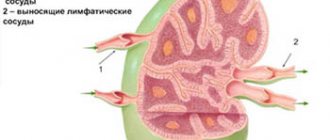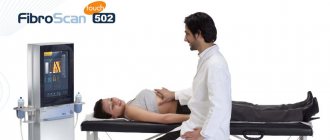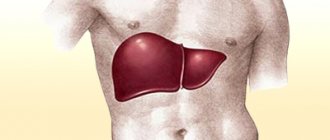Mark Anatolyevich, what could be the reason for liver enlargement?
- In general, liver enlargement itself is just a symptom of the disease. It is necessary to first find out the cause of the disease, and then eliminate it.
Diseases that contribute to liver enlargement are cirrhosis and fatty hepatosis (fatty liver).
These diseases are chronic and are caused by various factors, including malnutrition, alcohol abuse, or infectious viral hepatitis.
General information
Pathological enlargement of the liver in medicine is called hepatomegaly .
This condition develops in many liver diseases, as well as in diseases of other organs and systems, chronic infections, parasite infection, tumor infiltration, etc. In liver diseases, this symptom is most often observed. In some cases, the liver can reach very large sizes and weigh more than 10 kg. However, when talking about what hepatomegaly is, it should be taken into account that an enlarged liver may indicate many pathological processes. Accordingly, the diagnosis of hepatomegaly means that the doctor must determine the underlying causes of this condition and provide adequate treatment. ICD diseases - K76 (other liver diseases). Why a person develops hepatomegaly, how this condition is treated, and what to do to prevent it will be discussed in this article.
Prices
The Euroonko clinic has a special offer for drainage of ascites in a day hospital - 63,300 rubles.
The price includes:
- Examination and consultation with an oncologist surgeon.
- Complete blood count, biochemical blood test, ECG.
- Ultrasound of the abdominal organs with determination of the level of free fluid
- Conducting laparocentesis with ultrasound navigation.
- Complex drug therapy aimed at restoring water and electrolyte balance.
Treatment of ascites is carried out using the most modern techniques and the best experience of Russian and foreign doctors. We specialize in the treatment of liver diseases and we know why other clinics could not help you. We know what can be done.
Book a consultation 24 hours a day
+7+7+78
Bibliography:
- Clinical recommendations of the Russian Society for the Study of the Liver and the Russian Gastroenterological Association for the treatment of complications of liver cirrhosis. – Text: electronic / V. T. Ivashkin, M. V. Mayevskaya, Ch. S. Pavlov [etc.] // Russian Journal of Gastroenterology, Hepatology, Coloproctology. – 2016. – No. 6 (4). – P. 71 – 102. – URL: https://www.gastro-j.ru/jour/article/view/73
- T.A.Baeva, D.N.Andreev, E.M.Mironova, D.T.Dicheva - Ascites: differential diagnosis and treatment. — Directory of a polyclinic doctor. No2, 2016.
- Alekseichik, S. E. Ascites. Differential diagnosis: method. recommendations / S. E. Alekseychik. – Mn.: BSMU, 2005. – 28 p.
- RC Oey, HR van Buuren, RA de Man. — The diagnostic work-up in patients with ascites: current guidelines and future prospects. OCTOBER 2016, VOL. 74, NO. 8
- Cirrhosis of the liver: study. allowance / D.Kh. Kalimullina [and others]; under general ed. A.B. Bakirova - Ufa: Vagant, 2016. - 83 p.
- Algorithm for diagnosis and treatment of liver cirrhosis: textbook / O.V. Ryzhkova; Federal State Budgetary Educational Institution of Higher Education ISMU of the Ministry of Health of Russia, Department of Faculty Therapy. – Irkutsk: IGMU, 2022. – 64 p.
- EASL clinical practice guidelines on the management of ascites, spontaneous bacterial peritonitis, and hepatorenal syndrome in cirrhosis. Journal of Hepatology 2010 vol. 53 j 397–417.
- I.V. Ivakhnenko, I.Yu. Kolesnikova, A.V. Ponomareva. Modern approaches to the prevention and treatment of complications of liver cirrhosis in an outpatient setting. medicinal bulletin No. 1 (81). 2022. Volume 15.
- Albumin in decompensated cirrhosis: new concepts and perspectives. – Direct text / M. Bernardi, P. Angeli, J. Claria [et al.] // Gut. – 2022. – No. 69 (6). – R. 1127 – 1138.
- Modern principles of diagnosis and treatment of complications of liver cirrhosis. N.G. Poteshkina, S.K. Adzhigaitkanova – Educational and methodological manual. – M., GBOU VPO RNIMU im. N.I. Pirogova, 2013. – p.44.
- Aithal GP, Palaniyappan N, China L, et al. Guidelines on the management of ascites in cirrhosis. doi:10.1136/gutjnl-2020-321790.
- American Association for the Study of Liver Diseases; European Association for the Study of the Liver. Hepatic encephalopathy in chronic liver disease: 2014 practice guideline by the European Association for the Study of the Liver and the American Association for the Study of Liver Diseases. – Direct text. // J Hepatol. – 2014. – No. 3 (61). – R. 642 – 59.
- Burden of liver diseases in the world. – Direct text / SK Asrani, H. Devarbhavi, J. Eaton, PS Kamath // J Hepatol. – 2022. – No. 70 (1). – R. 151 – 171.
- Current and future pharmacological therapies for managing cirrhosis and its complications. – Direct text / D. Kockerling, R. Nathwani, R. Forlano // World J Gastroenterol. – 2022. – No. 25 (8). – R. 888 – 908.
- The European Association for the Study of the Liver. EASL Clinical Practice Guidelines for the management of patients with decompensated cirrhosis. – Direct text // J Hepatol. – 2022. – No. 69 (2). – R. 406 – 460.
Pathogenesis
Speaking about the pathogenesis of this condition, experts consider several possible options for its development. In this case, either a true enlargement of the liver may occur due to damage to the vascular bed, a neoplastic or infectious process, or other changes - intoxication, degenerative, traumatic, endocrine, autoimmune. Changes can also occur at the anatomical level.
With the development of pathological processes, the liver increases in size and its structure becomes denser. In hepatosis, the process is caused by dystrophic changes in the liver cells, in acute hepatitis - by lymphomacrophage infiltration. If cirrhosis , nodes form in the liver and fibrosis occurs. If the veins of the liver are affected or heart failure , the enlargement of the organ is associated with blood stagnation. With tumors and abscesses focal changes occur.
Classification
When making a diagnosis, the condition is classified from an anatomical and morphological point of view. The following types of damage are distinguished:
- bile ducts;
- parenchyma;
- connective tissue;
- vascular network.
In addition, during the diagnostic process it is noted whether hepatomegaly is combined with jaundice , enlarged spleen or ascites .
Hepatosplenomegaly is an enlargement of the liver and spleen. This condition can occur in a number of diseases and conditions. These are liver diseases, infectious and parasitic diseases, metabolic diseases, etc. Since an enlarged liver and spleen is a typical manifestation of many diseases, it is very important to promptly identify this condition and conduct additional examinations.
Taking into account the degree of liver enlargement, the following types of hepatomegaly are distinguished:
- Moderate – the size and structure are slightly changed. Moderate hepatomegaly is the easiest to treat.
- Pronounced - the organ is enlarged by 10 cm relative to the norm.
- Diffuse – an increase of more than 10 cm.
Partial hepatomegaly is distinguished separately, which is characterized by an uneven increase - the process affects only a part or one lobe.
Depending on the reasons for the development of such a pathological process, the following forms are distinguished:
- Drug injury – develops as a side effect when using certain medications.
- Toxic damage - occurs as a result of the influence of toxins - household (polluted air), natural (consumption of poisonous mushrooms), industrial (work in hazardous enterprises).
- Alcoholism is a very common form. fatty liver , alcoholic hepatitis , fibrosis , and cirrhosis can develop .
- Viral infection - occurs due to infection with hepatitis B and C.
- Infectious lesions - characteristic of mononucleosis , hepatitis A.
- Immune damage is a consequence of malfunctions in the immune system, when antibodies “erroneously” act on the liver.
- Cancerous lesion is a consequence of oncological processes. It can develop with ineffective treatment of hepatitis and cirrhosis .
- Dystrophic damage is a consequence of changes in the volume of liver cells and the accumulation of fat in them. This type of injury is called hepatic coma and can be fatal.
What is the treatment?
— One of the most common causes of liver disease is viral hepatitis. In this case, antiviral therapy is prescribed.
If it is toxic, alcoholic hepatitis, then you need abstinence from alcohol, medication support and diet.
In case of fatty hepatosis associated with excess body weight, measures aimed at reducing excess body weight, diet, drug treatment, and surgical intervention if necessary are prescribed.
In the case of cirrhosis, that is, more severe liver damage, treatment is more difficult, but it is possible. First of all, therapy is aimed at eliminating the causes of cirrhosis.
The next step will be treatment with various medications that allow the liver to function more optimally. Well, the last resort treatment for cirrhosis is liver transplantation.
Causes of liver enlargement
Liver enlargement can be caused by various reasons. In adults and children, this organ may enlarge due to the influence of one or more factors.
Most often, the causes of enlargement of the left lobe of the liver or the right lobe are associated with the following diseases and conditions:
- Neoplastic processes - the development of tumors, mainly metastatic, as well as hemangiomas or adenomas .
- Disturbances in the vascular bed - the hepatic and portal veins can be affected due to the formation of a blood clot. Also, such disorders may be a consequence of pathology of the hepatic artery, Budd-Chiari syndrome .
- Degenerative lesions - non-alcoholic steatohepatitis , steatohepatosis .
- The influence of substances toxic to the liver - alcohol abuse, taking medications.
- Infectious viral processes - infectious mononucleosis , viral hepatitis , nonspecific cholangitis , etc.
- Autoimmune diseases.
- Amyloidosis.
- Endocrine disorders.
- Congenital pathologies.
- Injuries.
In addition, experts identify some factors that increase the likelihood of developing hepatomegaly:
- Regular alcohol abuse.
- Long-term use of high doses of medications, vitamins, biological additives.
- Excess weight , unhealthy and irrational nutrition.
Symptoms of liver enlargement
Signs of hepatomegaly are associated primarily with true enlargement of the liver. It is diagnosed if the size of the organ along the right midclavicular line is more than 12 cm, or its left lobe is palpated in the epigastric region. In normal condition, the liver is soft and can be easily felt under the ribs.
It is also important to take into account the fact that there are no nerve endings in the liver, so even with the development of pathological processes, symptoms may not appear. Often, in the initial stages, adults periodically experience only minor discomfort or pain at the location of the organ. Only during an ultrasound examination can characteristic echo signs be determined.
Symptoms of liver enlargement
Consequently, signs of liver enlargement in adults, and sometimes in children, are often diagnosed already in the later stages, when the pathological process is already actively developing. Then a more pronounced clinical picture is observed. If the liver is enlarged by 2 cm or more, the following signs may be observed as the pathological process develops:
- Discomfortable sensations in the area of the right hypochondrium. They may worsen after eating and physical exertion.
- A feeling of heaviness after consuming a small amount of water or food.
- Periodic heartburn .
- Belching with an unpleasant odor.
- Disorders of the digestive system - constipation , diarrhea , nausea, periodic vomiting. Possible vomiting of bile.
- Discolored stool that may contain particles of undigested food.
- Yellowness of the skin and mucous membranes, yellowness of the sclera of the eyes. The skin may also take on a sallow tone.
- Itchy skin.
- Sudden mood swings, irritability.
- Drowsiness or insomnia .
- Tachycardia.
- Heavy sweating.
- High blood pressure .
- Pain in the chest area, feeling of tightness.
- When palpating the liver at a doctor's appointment, a person may feel pain.
Tests and diagnostics
To determine the presence of hepatomegaly and the causes of such manifestations, the examination is carried out according to the following scheme:
- The doctor conducts a detailed survey of the patient about complaints and examines the medical history.
- Next, palpation is performed to determine the size, boundaries and density of the liver.
- It is important to determine the results of a general and biochemical blood test. Using the data obtained, it is possible to determine the presence of infectious and inflammatory processes and assess the level of liver enzymes . A general urine test is also performed.
- Markers of viral hepatitis are determined.
- An ultrasound of the liver is performed. This is a fairly informative method that allows you to determine the condition of the liver, portal vein, and hepatic artery.
- Informative studies are CT and MRI.
- If necessary, the doctor prescribes a laparoscopic examination.
- According to indications, a puncture is performed and material is taken for a biopsy .
In the normal state of the organ, its length is 14-20 cm, its cross-sectional size is 20-22.5 cm, in the sagittal plane - 9-12 cm. The length of the right lobe is 11-15 cm, the thickness of the left lobe is approximately 6 cm, and its height is less than 10 cm. Deviations can be no more than 1.5 cm.
Hepatomegaly is diagnosed if the size of the organ exceeds 12 cm or an increase in the left lobe of the liver is noted (in this case it is palpated in the epigastric region). During the diagnostic process, liver prolapse and the location of other tissues in the right upper quadrant (this could be tumors, an enlarged gallbladder) are also excluded.
About the organ and the disease
The liver is a multifunctional organ. One aspect of her work is cleansing the body. Being a kind of filter, the liver collects blood from the intestines through the portal vein and cleanses it of toxins.
The most serious organ disease is cirrhosis. It is a pathological process in which healthy tissues die and are replaced by fibrous ones. Such damage is so serious that it is irreversible and leads to a complete cessation of organ function.
As for ascites, this pathology is characterized by excessive accumulation of liquid masses in the abdominal cavity. It is secondary in nature, and complicates cirrhosis of the liver and some other diseases.
If the necessary medical care is not provided in time, the disease will be accompanied by electrolyte disturbances and protein loss. This entails a deterioration in the functioning of internal organs, which greatly aggravates the prognosis of the underlying disease.
Ascites in liver cirrhosis begins to develop due to a significant increase in pressure in the portal vein.
In the normal state of the peritoneum, a small amount of fluid is constantly present in it; the peritoneum absorbs it back without problems.
An excessive increase in pressure in the portal vein gives impetus to a whole cascade of pathological reactions. They lead to an imbalance in the functioning of the peritoneum: it is simply no longer able to absorb liquid. Thus, liquid masses accumulate in the abdominal cavity.
Treatment with folk remedies
For hepatomegaly, any folk remedies should be used very carefully and in no case should they replace the main treatment. Before using any traditional method, you should consult your doctor about the advisability of its use. In addition, traditional methods also have certain contraindications.
- Milk thistle tea . This medicinal plant protects liver cells and promotes the regeneration of new ones. Also acts as an anti-inflammatory agent. The main active component of the plant is silymarin, which is part of a number of hepatoprotective drugs. To prepare milk thistle tea, you need 1 tsp. Pour 200 ml of boiling water over the seeds of the plant. After half an hour, strain and drink warm in two doses.
- Infusion of immortelle . The inflorescences of this plant contain a lot of flavonoids that have hepatoprotective activity. The use of products with immortelle helps restore the detoxification function of the liver. To prepare an infusion of immortelle, add 10 g of flowers to 250 ml of water and heat the container in a water bath for half an hour. After 10 minutes, strain and squeeze. Add water so that the total amount of product is 250 ml. Drink in 4 doses throughout the day.
- Rose hip decoction . Rose hips also contain many flavonoids. Rosehip helps eliminate spasms of the bile ducts, has a beneficial effect on the digestion process, and produces an anti-inflammatory effect. To prepare a decoction, add 200 g of berries to 1 liter of water, bring to a boil and cook for 15 minutes. Strain, drink 150 ml 4 times a day.
- Collection of herbs . This collection may include oregano, nettle, chamomile, calendula, centaury. Herbs should be mixed in equal proportions and an infusion should be prepared by pouring 2 tsp. mixture 250 ml water.
- Beetroot, pumpkin . These vegetables should be included in the menu more often, preparing a variety of dishes from them. Raw pumpkin is beneficial, as is freshly squeezed beet juice.
Treatment of ascites in cirrhosis
According to medical statistics, the vast majority (up to 90%) of patients with diagnosed ascites take diuretics and are on a special diet that helps restore water-salt balance.
Among the drugs used:
- Hepatoprotectors;
- Diuretics;
- Albumin and some others.
Surgery is performed if therapy is ineffective. This often happens with cancer patients. A separate group consists of patients with cancer in its later stages, in whom a large amount of fluid has accumulated in the abdomen.
In this case, to eliminate ascites, laparocentesis is used, which is puncture of the peritoneal wall with subsequent removal of fluid. Some of these patients require drainage. Through it, the accumulated liquid is evacuated within a few more days.
Intracavitary chemotherapy, in which the drug is injected directly into the peritoneal cavity, is also applicable to combat ascites against the background of cirrhosis.
Concluding the story about surgical interventions for cirrhosis aggravated by ascites, let’s name their varieties:
- If therapy is ineffective, laparocentesis is used;
- Shunting is performed to reduce pressure in the portal vein.
- Organ transplant.
Prevention
The essence of prevention is to prevent diseases that lead to liver enlargement. To do this, it is important to follow the following recommendations:
- Eat right and do not abuse unhealthy foods, control your intake of carbohydrates and fats.
- Get rid of bad habits.
- Avoid uncontrolled use of medications, carrying out drug treatment only as prescribed by a doctor.
- Follow all hygiene rules to avoid parasitic or viral infection.
- Those who have suffered from liver disease should undergo regular preventive examinations with a doctor.
- Practice regular physical activity, but it should not be excessive.
What cases from practice related to liver disease do you remember?
— Severe liver damage occurs with viral hepatitis, when a person for a long time did not know that he had a virus, for example, hepatitis C. This hepatitis can be asymptomatic for many years, ultimately leading to cirrhosis of the liver.
That is, a person lived a normal life and suddenly he began to develop symptoms of cirrhosis. Upon further examination, it turned out that the patient’s liver functions were impaired, the disease was already at a serious stage, and the person was on his way to the operating table for a transplant. We have to fight such cirrhosis, and we are talking about survival, not about cure.
In children
Hepatomegaly in a child may be associated with neonatal jaundice. In a small child, it develops due to birth injuries, as well as dysfunction of the mother’s endocrine system. As a rule, liver enlargement in newborns does not require treatment and goes away within a month.
Minor hepatomegaly, which is determined by palpation or ultrasound in a child under 7 years of age, is also considered a physiological phenomenon. It is normal if the liver protrudes beyond the edges of the ribs by 1-2 cm. The condition, as a rule, normalizes as the child grows. However, if an increase in the right lobe of the liver or its left lobe is detected, it is better to undergo additional studies to exclude the development of diseases.
An enlargement of the left or right lobe of the liver in children may be associated with the following diseases and conditions:
- inflammatory processes;
- toxic damage;
- congenital TORCH infections;
- dysfunction of the biliary tract;
- metabolic disorders;
- tumors, metastases.
A particular cause for concern is the situation when hepatomegaly in children is combined with other alarming symptoms: fever, vomiting, rashes, weight loss, poor appetite, yellowness of the skin and mucous membranes. In this case, you should immediately consult your doctor.
Diet
Diet for an enlarged liver (hepatomegaly)
- Efficacy: no data
- Timing: constantly
- Cost of products: 1400-1500 rubles. in Week
Diet is one of the important components of complex treatment of this condition. If the increase is insignificant, sometimes only nutritional correction can normalize the condition of the organ.
First of all, it is important to limit the amount of salt to 6-7 g per day and the amount of sugar to 50 g per day. You should drink up to 2 liters of water daily. You need to eat fractionally - up to 6 times a day in small portions.
For hepatomegaly, it is recommended to include the following foods and dishes in the diet:
- Low-fat dairy products.
- Vegetables – fresh, as well as stewed, baked and boiled.
- Lean meat, fish.
- Vegetable soups.
- Vegetable oils.
- Fruits.
- Marmalade, dried fruits, honey, biscuits.
- Cereals.
- Egg white.
The following foods should be excluded from your diet:
- Spicy, fried, salty dishes.
- Smoked meats and canned goods.
- Fatty meat and fish.
- Mushrooms.
- Egg yolk.
- Legumes.
- Sorrel, spinach, radish, onion.
- Fatty dairy products.
- Muffins, baked goods, cocoa, nuts.
- Alcohol.
- Soda, coffee, sour juices.
Sample menu for a week with an enlarged liver
Monday.
Meal 1 – Milk rice porridge without adding butter and sugar, green tea with honey or rosehip decoction.
Meal 2 – Boiled river fish
Meal 3 – Boiled carrots, grated
Meal 4 – Steamed vegetable dish (without salt and spices)
Meal 5 – Fresh fruit
Tuesday
Meal 1 – Omelet from one egg (without yolk), rosehip decoction or green tea
Meal 2 – Dried fruits (dried apricots, prunes, raisins), previously poured with boiling water.
Meal 3 – Veal or chicken broth, bran bread
Meal 4 – Low-fat cottage cheese
Meal 5 – Salad of greens and cucumbers
Wednesday
Meal 1 – Low-fat kefir or cottage cheese
Method 2 – Rosehip decoction with honey
Method 3 – Steamed meatballs
Meal 4 – Pumpkin puree, herbal tea
Meal 5 – Baked cheesecakes with dried fruits
Thursday
Meal 1 – Oatmeal with milk, green tea with honey and lemon
Meal 2 – Compote with dried fruits
Meal 3 – Steamed river fish, bran bread
Meal 4 – Vegetable casserole, bran bread
Meal 5 – Herbal tea
Friday
Meal 1 – Boiled pasta in small quantities
Meal 2 – Dietary buckwheat soup, bran bread
Meal 3 – Dried fruits soaked in boiling water
Meal 4 – Milk porridge
Meal 5 – Green tea with honey
Saturday
Meal 1 – Buckwheat porridge cooked in water without salt and sugar, herbal tea
Meal 2 – Fruit platter
Meal 3 – Veal or chicken broth, bran bread
Meal 4 – Sauerkraut salad
Meal 5 – Pastila or fruit marmalade
Sunday
Meal 1 – Cheese pancakes with dried fruits, cooked in the oven, green tea with honey and lemon
Meal 2 – Veal or turkey, boiled and pureed with the addition of boiled carrots or pumpkin
Meal 3 – Rosehip decoction, bran bread
Meal 4 – Kefir or cottage cheese
Meal 5 – Fruit or vegetable salad
It is also necessary to maintain equal periods of time between meals. Any diet must be discussed with a doctor, who will give all the necessary recommendations. With an enlarged liver, nutrition should be optimally balanced. Therefore, it is periodically necessary to adjust and diversify the diet. Alcohol, coffee, chocolate, confectionery, salt, pepper, vinegar are the main enemies of the liver. For any liver disease, legumes in any form, nuts, and carbonated drinks are contraindicated.










